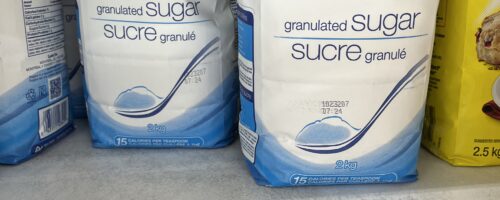
Calle Xico, Xocoyote esq, Arenal 4ta Secc, Venustiano Carranza, 15640 CDMX, Mexico
How is it produced?
According to the Canadian Sugar Institute, sugar primarily comes from sugar cane, a plant mostly grown in areas near the equator. The sugar is extracted from this plant and refined in refineries.
Describe the supply chain to the store shelf in Canada:
According to the Canadian sugar institute, most of the sugar cane imported into Canada comes from Central America and Mexico. It is imported as sugar cane and then refined in domestically owned refineries. It is then sold to grocery stores, etc. for mass consumption.
What is the power balance between the producer and seller?
In the case of Mexico – a major exporter of sugar cane to Canada – Canada has the upper hand in this relationship. This is largely because of a history of bad trade deals (such as NAFTA) and financial transnational institutions cajoling Mexico into privitization schemes and neoliberal market opening policies that ultimately resulted in bankruptcies and mismanagement by over-ambitious industrialists in the private sector.
Can you recommend changes to the system to improve the balance?
In the case of NAFTA – which I believe has already been renegotiated – reexamine the original intentions of the trade deal and compare them to the actual results for Mexico. Based on that, find a way to either compensate or rejuvenate Mexico. On the privitization front, more over-sight on how private sector industrialists take over formerly public factories and sugar refineries would allow for a smoother transition when attempting future privatisation schemes.
References/Resources:
Chatzky, A. & McBride, J. (2020, July 1). NAFTA and the USMCA: Weighing the Impact of North American Trade. Council on Foreign Relations. https://www.cfr.org/backgrounder/naftas-economic-impact
Chollett, Donna L. (2013). Chapter Four The Neoliberal Turn & Privatization of Mexico’s Sugar Industry. In Neoliberalism, Social Exclusion, and Social Movements : Resistance and Dissent in Mexico’s Sugar Industry (pp. 63-83). Lexington Books/Fortress Academic. https://ebookcentral-proquest-com.ezproxy.tru.ca/lib/trulibrary-ebooks/reader.action?docID=4767638&ppg=77
Chollett, Donna L. (2013). Chapter Five NAFTA and the Neo-Globalization of Sugar. In Neoliberalism, Social Exclusion, and Social Movements : Resistance and Dissent in Mexico’s Sugar Industry (pp. 85-96). Lexington Books/Fortress Academic. https://ebookcentral-proquest-com.ezproxy.tru.ca/lib/trulibrary-ebooks/reader.action?docID=4767638&ppg=77
Ellwood, W. (2015). Globalization Buying and Selling the World (4th ed). Between the Lines.
Mintz, S. W. (1986). 1. Food, Sociality, and Sugar. Sweetness and Power: The place of sugar in modern history. New York: Penguin. https://moodle.tru.ca/pluginfile.php/1932536/mod_resource/content/1/POLI3991_Food%20Sociality%20and%20Sugar.pdf
Richardson, B. & Ngwenya, P. R. (2013). Cut Loose in the Caribbean: Neoliberalism and the Demise of the Commonwealth Sugar Trade. Bulletin of Latin American Research, 32(3), 263-278. https://eds-p-ebscohost-com.ezproxy.tru.ca/eds/pdfviewer/pdfviewer?vid=8&sid=ffdb368e-0066-4f95-997d-253dda7ce690%40redis
(2023). Canadian Sugar Industry Statistics. Canadian Sugar Institute. https://sugar.ca/international-trade/canadian-sugar-market/canadian-sugar-industry-statistics
(2023). Geography of Sugar. Canadian Sugar Institute. https://sugar.ca/sugar-basics/geography-of-sugar
(2023). History. Lantic Rogers. https://www.lanticrogers.com/en/about-us/history/
(2023). Fine White Granulated Sugar. Lantic Rogers. https://www.lanticrogers.com/en/products/fine-white/

